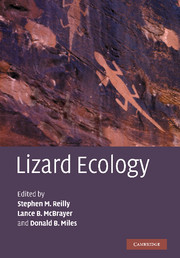Lizard Ecology
Langue : Anglais
Coordonnateurs : Reilly Stephen M., McBrayer Lance B., Miles Donald B.

Originally published in 2006, this book was the first critical review of the effects of lizard foraging modes in 30 years.
The foraging mode of lizards has been a central theme in guiding research in lizard biology for three decades. Foraging mode has been shown to be a pervasive evolutionary force molding the diet, ecology, behavior, anatomy, biomechanics, life history, and physiology of lizards. This 2007 volume reviews the knowledge on the effects of foraging mode on these and other organismal systems to show how they have evolved, over a wide taxonomic survey of lizard groups. The reviews presented here reveal the continuous nature of foraging strategies in lizards and snakes, providing the reader with a review of the field, and will equip researchers with fresh insights and directions for the sit-and-wait vs. wide foraging paradigm. This will serve as a reference book for herpetologists, evolutionary biologists, ecologists and animal behaviorists.
Preface Stephen M. Reilly, Lance D. McBrayer, and Donald B. Miles; Historical introduction: on widely foraging for Kalahari lizards Raymond B. Huey and Eric R. Pianka; Part I. Organismal Patterns of Variation with Foraging Mode: 1. Movement patterns in lizards: measurement, modality, and behavioral correlates Gad Perry; 2. Morphology, performance and foraging mode Donald B. Miles, Jonathan B. Losos and Duncan J. Irschick; 3. Physiological correlates of lizard foraging mode Kevin E. Bonine; 4. Lizard energetics and the sit-and-wait vs. wide-foraging paradigm Tracey Brown and Kenneth A. Nagy; 5. Feeding ecology in the natural world Eric R. Pianka and Laurie J. Vitt; 6. Why is intraspecific niche partitioning more common in snakes than in lizards? Richard Shine and Mike Wall; 7. Herbivory and foraging mode in lizards Anthony Herrel; 8. Lizard chemical senses, chemosensory behavior, and foraging mode William E. Cooper, Jr.; 9. Patterns of head shape variation in lizards: morphological correlates of foraging mode Lance D. McBrayer and Clay Corbin; 10. Prey capture and prey processing behavior and the evolution of lingual and sensory characteristics: divergences and convergences in lizard feeding biology Stephen M. Reilly and Lance D. McBrayer; 11. The meaning and consequences of foraging mode in snakes Steven J. Beaupre and Chad Montgomery; Part II. Environmental Influences on Foraging Mode: 12. The foraging biology of the Gekkota: life in the middle Aaron M. Bauer; 13. Foraging mode in the African cordylids and plasticity of foraging behavior in Platysaurus broadleyi Martin Whiting; 14. Interactions between habitat use, behaviour and the trophic niche of lacertid lizards Bieke Vanhooydonck, Anthony Herrel and Raoul Van Damme; 15. Food acquisition modes and habitat use in lizards: questions from an integrative perspective Roger Anderson; 16. The evolution of foraging behavior in the Galápagos marine iguana: natural and sexual selection on body size drives ecological, morphological, and behavioral specialization Maren N. Vitousek, Dustin R. Rubenstein and Martin Wikelski; 17. The evolution of the foraging mode paradigm in lizard ecology Stephen M. Reilly, Donald B. Miles and Lance D. McBrayer.
Date de parution : 09-2012
Ouvrage de 546 p.
17x24.4 cm
Date de parution : 07-2007
Ouvrage de 558 p.
18x25.5 cm
Thème de Lizard Ecology :
© 2024 LAVOISIER S.A.S.



